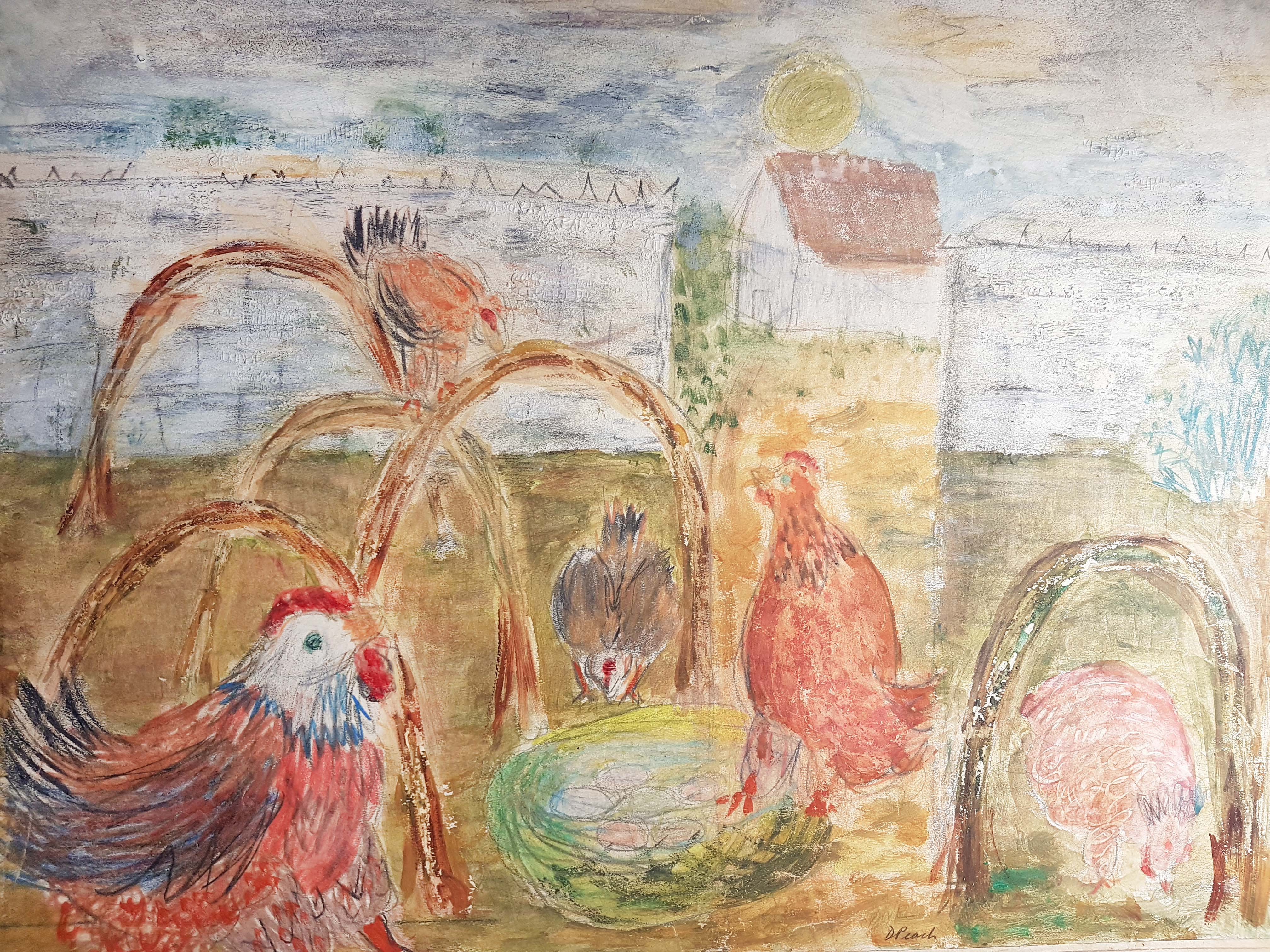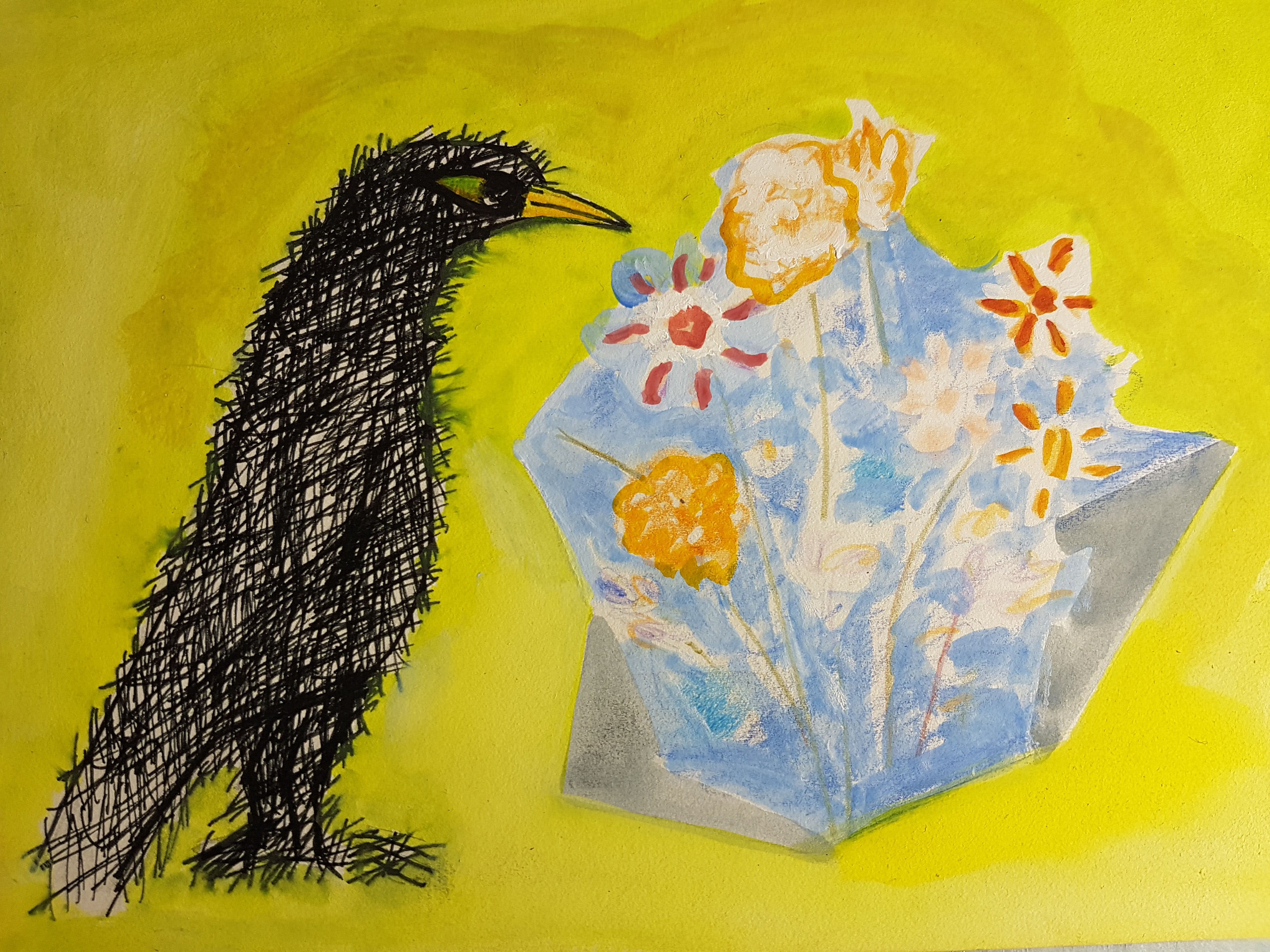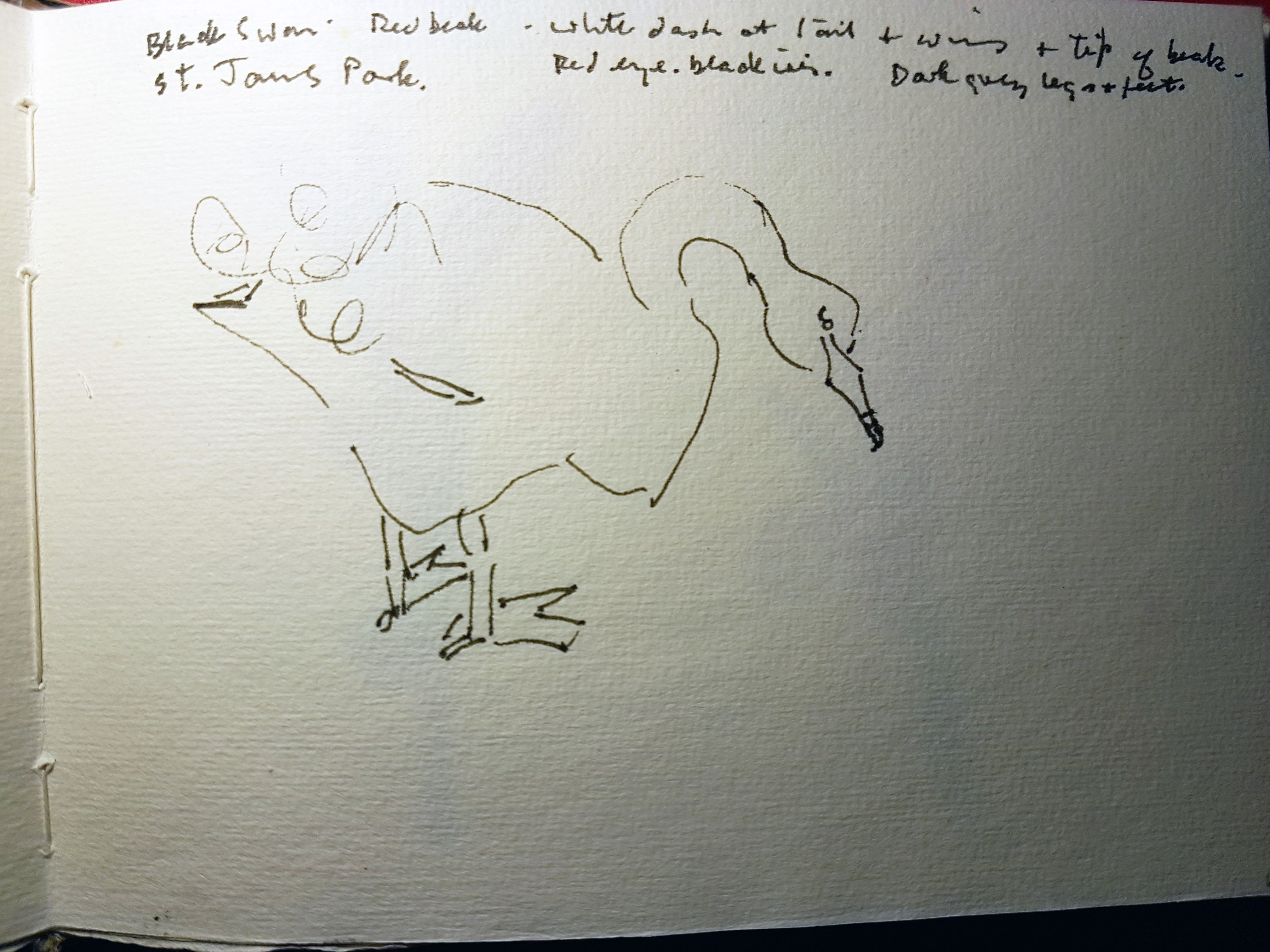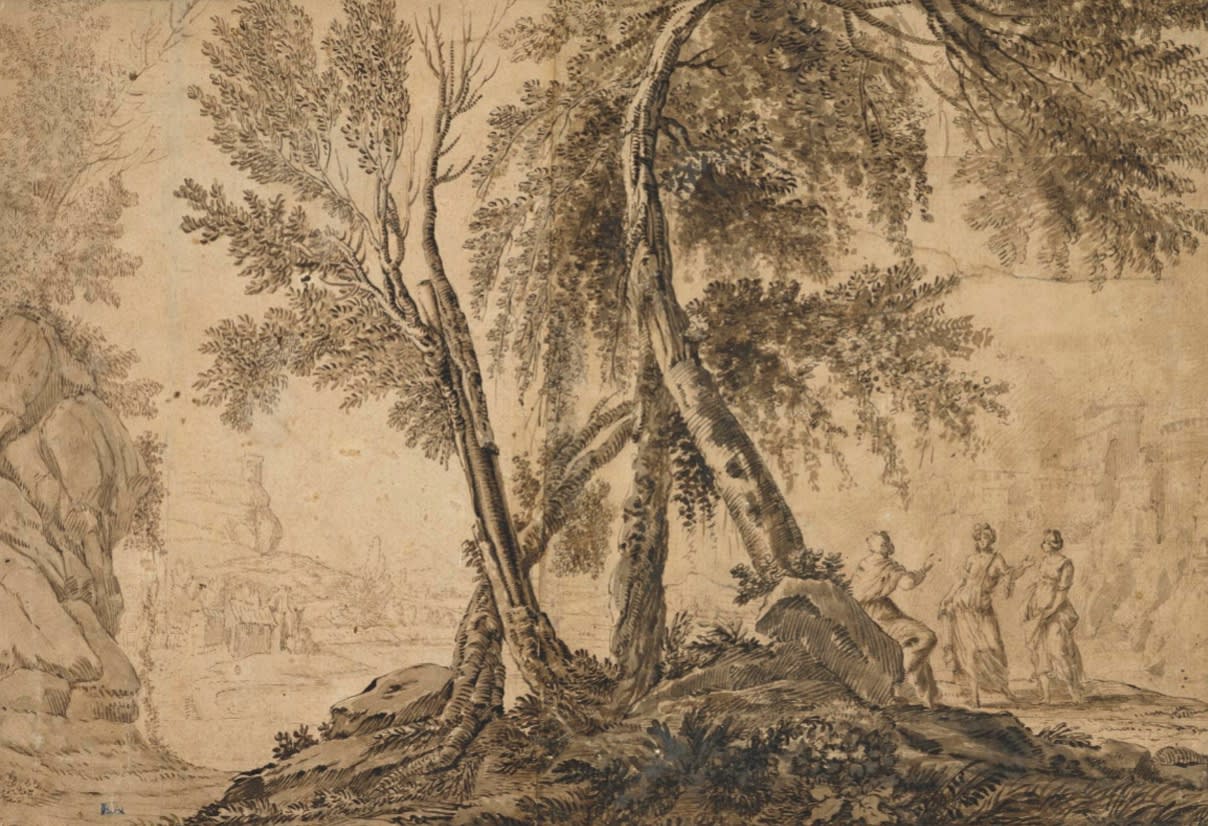
As the countdown to Christmas begins, we thought we’d get festive!
Most people are familiar with the song ‘The Twelve Days of Christmas’ (even if we can’t always remember all the categories and quantities!). It was first published in 1780, but had been known and passed down orally for much longer. The song relates to the period between Christmas and Epiphany, and we do hope you will excuse us for getting into the festive mode a little early.
We set ourselves the challenge of seeing whether our fabulous collections could enable us to illustrate the song, and here’s what we’ve come up with.
On the first Day of Christmas…
Sadly, partridges and identifiable pear trees are not to be found in the RSA Collections. However, there are a number of still lives which feature pears. Though tasty, they are not always the most appealing colour, but as luck would have it here’s one with the solitary pear we hoped for, and look at its festive colour! We’ve selected David McClure RSA’s Flowers with Red Pear, gifted to the academy by the artist in 1986.

Sir William G Gillies RSA (1898-1973), Pigeons on a Doocot (c.1937). Oil on canvas, Gillies Bequest 1973.
On the second day of Christmas…
Well with the weather turning colder, it’s good to know that these lovely birds (two turtle doves) are well looked after. One of the finest renditions of a doo’cot is this abstract oil by Sir William George Gillies RSA. This year, we’re celebrating 125 years since Gillies’ birth with Modernism and Nation, an anniversary exhibition of work by the renowned Academician. When he died, Gillies bequeathed his entire estate to the RSA, a gift which continues to inspire.

Dorothy M Peach, Hens, Hoops and Eggs. Watercolour and gouache on paper, Gillies Bequest 1973.
On the Third Day of Christmas…
Cheekily, we’ve swerved the French connection here by claiming that without hearing them cluck, we can’t tell what nationality the hens that feature in several of our works actually are! This is our most colourful rendition of hens, and there are three of them (plus a bonus couple). It’s by Dorothy M Peach who was a student at Edinburgh College of Art under William Gillies RSA, from whose bequest in 1973 this work came.

David Alan Redpath Michie RSA (1928-2015), Blackbird and Flowers. Mixed media on card, David Michie Bequest 2015.
On the Fourth Day of Christmas…
The “calling birds” appear in the first published version as “colly birds.” A recent recipient of one of our John Kinross Travel Scholarships, an annual award which facilitates a dozen students at the Scottish Art Schools the opportunity to travel to Italy, was David McCulloch. David goes by the familiar name “Cully”, but we thought that link might be a little tenuous. The colly, or calling birds, were songbirds - in particular thrushes or blackbirds. Here’s Blackbird and Flowers by David Michie RSA. The little chap looks like he’s just opened his own Christmas present, a box of flowers.

Uist Corrigan (b.1992), Hooks and Rings (2015-16). Mixed media, John Kinross Travel Scholarship 2014 deposit 2016.
On the Fifth Day of Christmas…
Surely, we all remember the five gold rings! The fabulous Ponte Vecchio in Florence straddles the River Arno. It carries a hotchpotch of buildings, as well as the carriageway. Originally it was the part of the city favoured by butchers, and they no doubt utilised the flowing waters below for waste disposal. However, in time it became associated with the city’s gold and silversmiths. This history is the influence behind Uist Corrigan’s installation piece Hooks and Rings – resplendent with (seven, oops!) gold (effect) rings. Corrigan is another former recipient of a John Kinross Scholarship.

Unknown artist (Japanese, 20th century) Goose-shaped Puppets. Mixed media, William Hunter Littlejohn RSA Bequest 2006.
On the Sixth Day of Christmas…
We’re halfway there now. One of the most famous paintings of geese is that by our 8th President, Sir James Guthrie PPRSA. It depicts a smart young girl leading a procession of geese behind her. The painting is sadly not in our collection, but in that of Aberdeen Art Gallery. Instead, we’ve identified these goose-shaped puppets. They were acquired by the Arbroath artist William Littlejohn RSA on a visit to Japan. Littlejohn was able to undertake his travel thanks to a W G Gillies Members Bursary. This fund is another of the many benefits accruing from the Gillies Bequest of 1973.

David Alan Redpath Michie RSA (1928-2015), Black Swan in St James’ Park, London. Mixed media on paper, David Michie Bequest 2015.
On the Seventh Day of Christmas…
Swans feature in William Walls RSA’s powerful Diploma Collection deposit, and in Philip Reeves RSA’s early etching. But the former is being attacked by a fox and the latter is very dead - hardly the thing for Christmas! When David Michie died in 2015, he bequeathed some work to the Academy. This was enhanced by a further “Studio Gift” from his family. Including this sketchbook, containing a study of a black swan in St James’ Park, London.

Albert Jansen Klomp (1618-88), A Milkmaid with Cattle. Mixed media on paper, David Laing Bequest 1879.
On the Eighth Day of Christmas…
Milking is largely an automated process nowadays but was formerly carried out, quite literally, by hand. It was a task that fell largely to women and girls to perform. Here one such milkmaid takes centre stage in this wash drawing by the 17th century Netherlandish artist Albert Klomp. The drawing is part of the David Laing Bequest of Scottish and Old Master drawings of 1879, one of the largest bequests ever made to the Academy.

Herman Swanevelt (1603-55), A Wide Landscape with Four Intertwining Trees in the Foreground; on the Right a Seated Monk Confronted by Two Girls Dancing. Ink and wash on paper, David Laing Bequest 1879.
On the Ninth Day of Christmas…
With all the feasting done, let’s shoogle it all down. We’ll start with ladies dancing. Here, another delightful drawing from the Laing Bequest of 1879. This one is by Herman Swanevelt and was executed in the second quarter of the 17th century.

William Brodie RSA (1815-81), Portrait of Lord Cockburn. Marble, RSA Diploma Collection deposit.
On the Tenth Day of Christmas…
Joining the dancing ladies we have the lords-a-leaping. Well, no leaping, but a good number of Lords to choose from. These range from Noblemen to Judges. We’ve opted for one of the latter; Lord Cockburn. A distinguished lawyer and advocate, he became a judge, and is remembered for his drafting of the first Scottish Reform Bill in the 1830s. He also influenced a change in opinion regarding the preservation of old buildings, including John Knox House on the Royal Mile. The Cockburn Association was named in his honour. But for us he will always be the champion whose efforts secured the future of the Academy through the Hope-Cockburn Award of 1829. William Brodie RSA deposited the bust as his Diploma Collection deposit following his election into the Academy.

Marian Leven RSA (b.1944) Pibroch (2011). Screenprint, gifted 2012.
On the Eleventh Day of Christmas…
Piping takes on various connotations, but we’ve gone Scottish for this one. The bagpipes, though not exclusive, are traditionally associated with Scotland. The term biproch is associated with them, which derives from the Gaelic word for piping, describing a genre of music associated with the Highlands. This screenprint is the result of a collaboration between Marian Leven RSA and the poet Robin Robertson. It came about through the project ‘Poetry Beyond Text: Vision, Text + Cognition'. The project resulted in a touring exhibition, which was mounted at the RSA in 2011.

Ian Hamilton Finlay HRSA (1925-2006) & Ron Costley (1939-2015), The Little Drummer Boy (1971). Screenprint, gifted 2018.
On the Twelfth Day of Christmas…
Since 1826, we’ve welcomed art practitioners, historians, and other distinguished persons to our Membership as Honorary Members. One such was the poet and activist, Ian Hamilton Finlay. Finlay collaborated with numerous fellow creatives during his long and productive life. Here his collaborator was Ron Costley. The work references Joseph Viala or Bara, a French drummer-boy who was martyred during the French Revolution. The reef knots in the boat’s rigging suggests the decoration on the sides of the revolutionaries’ drums.
Explore RSA Collections further, and find a work you'd like to send your true love, via our collections online portal.

